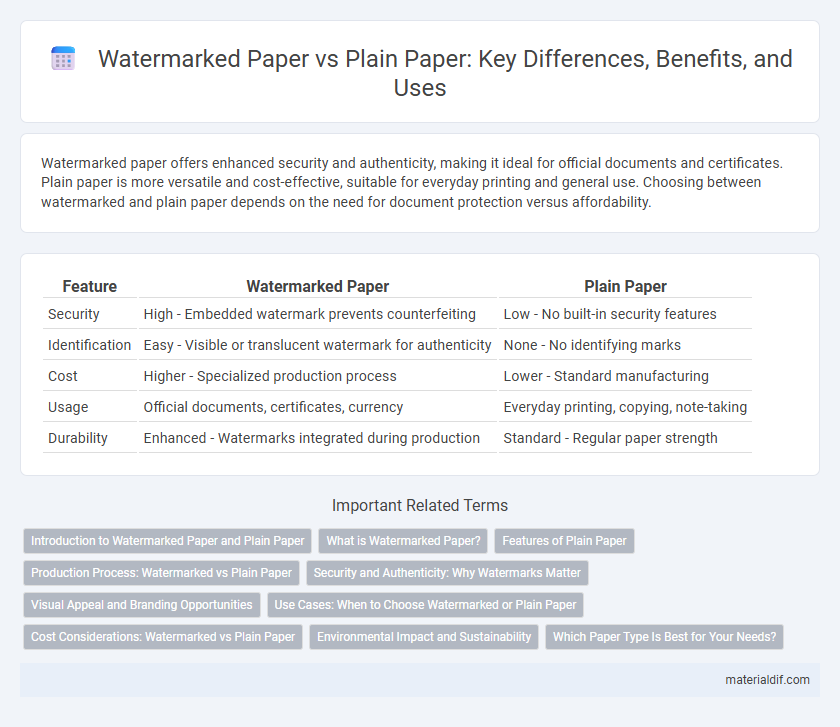Watermarked paper offers enhanced security and authenticity, making it ideal for official documents and certificates. Plain paper is more versatile and cost-effective, suitable for everyday printing and general use. Choosing between watermarked and plain paper depends on the need for document protection versus affordability.
Table of Comparison
| Feature | Watermarked Paper | Plain Paper |
|---|---|---|
| Security | High - Embedded watermark prevents counterfeiting | Low - No built-in security features |
| Identification | Easy - Visible or translucent watermark for authenticity | None - No identifying marks |
| Cost | Higher - Specialized production process | Lower - Standard manufacturing |
| Usage | Official documents, certificates, currency | Everyday printing, copying, note-taking |
| Durability | Enhanced - Watermarks integrated during production | Standard - Regular paper strength |
Introduction to Watermarked Paper and Plain Paper
Watermarked paper contains a distinctive design or pattern embedded during the manufacturing process, enhancing security and authenticity for documents such as certificates and currency. Plain paper lacks these embedded features, offering a smooth, uniform surface primarily used for everyday printing and writing tasks. The choice between watermarked and plain paper depends on the required level of document validation and protection.
What is Watermarked Paper?
Watermarked paper features a distinctive design embedded during the manufacturing process, creating subtle patterns visible when held against light, enhancing authenticity and security. This type of paper is commonly used for official documents, certificates, and currency to prevent counterfeiting and verify legitimacy. In contrast, plain paper lacks these embedded marks, making it more suitable for everyday printing and copying without additional security features.
Features of Plain Paper
Plain paper features a smooth, even texture that provides excellent print clarity and ink absorption, making it ideal for everyday printing and writing tasks. It is versatile, compatible with various printing technologies such as inkjet and laser printers, and typically more cost-effective than watermarked paper. Unlike watermarked paper, plain paper lacks embedded security marks, prioritizing affordability and general usability over authentication features.
Production Process: Watermarked vs Plain Paper
Watermarked paper requires an additional step in production where a design or pattern is embedded into the paper fibers during the wet pulp stage, typically using a dandy roll or a cylinder mold. This process contrasts with plain paper production, which involves uniformly pressing and drying pulp without any embedded patterns. The watermarked technique demands precise control and specialized equipment, resulting in higher production costs and longer manufacturing times.
Security and Authenticity: Why Watermarks Matter
Watermarked paper enhances security by embedding unique, often intricate designs into the paper fibers, making counterfeiting significantly more difficult compared to plain paper. These watermarks serve as a reliable authenticity indicator for official documents, certificates, currency, and legal papers. Incorporating watermark technology ensures verification of origin and deters fraudulent replication, a critical factor in maintaining document integrity.
Visual Appeal and Branding Opportunities
Watermarked paper offers enhanced visual appeal through its subtle, embedded designs that create a sophisticated and professional look, making it ideal for high-end branding. The watermark provides an exclusive branding opportunity by serving as a unique identifier that communicates authenticity and quality. In contrast, plain paper lacks these intrinsic branding features, resulting in a more generic appearance that may reduce the perceived value of printed materials.
Use Cases: When to Choose Watermarked or Plain Paper
Watermarked paper is ideal for official documents, certificates, or legal papers where authenticity and security are paramount, as the watermark deters forgery and adds a professional touch. Plain paper is suitable for everyday printing, note-taking, and general office use due to its cost-effectiveness and versatility. Choosing watermarked paper enhances brand legitimacy and document integrity, while plain paper offers simplicity and wide accessibility for routine tasks.
Cost Considerations: Watermarked vs Plain Paper
Watermarked paper generally incurs higher production costs due to the specialized manufacturing process that integrates the watermark during paper formation, resulting in increased pricing compared to plain paper. Plain paper offers a cost-effective solution for bulk printing needs, with standard manufacturing techniques that minimize expenses. When evaluating cost considerations, watermarked paper serves as a premium option primarily justified by enhanced security features and brand authenticity rather than budget-friendly procurement.
Environmental Impact and Sustainability
Watermarked paper often requires specialized production processes that consume more energy and resources compared to plain paper, increasing its environmental impact. Plain paper, typically produced with fewer additives, tends to have a smaller carbon footprint and higher recyclability, contributing to better sustainability outcomes. Choosing plain paper supports reduced deforestation and lower emissions in the paper manufacturing industry.
Which Paper Type Is Best for Your Needs?
Watermarked paper offers enhanced security and authenticity, ideal for official documents, certificates, and legal paperwork where fraud prevention is crucial. Plain paper provides versatility and cost-effectiveness for everyday printing, copying, and casual use without specialized features. Choosing between watermarked and plain paper depends on the need for document verification versus general usage and budget considerations.
Watermarked paper vs Plain paper Infographic

 materialdif.com
materialdif.com